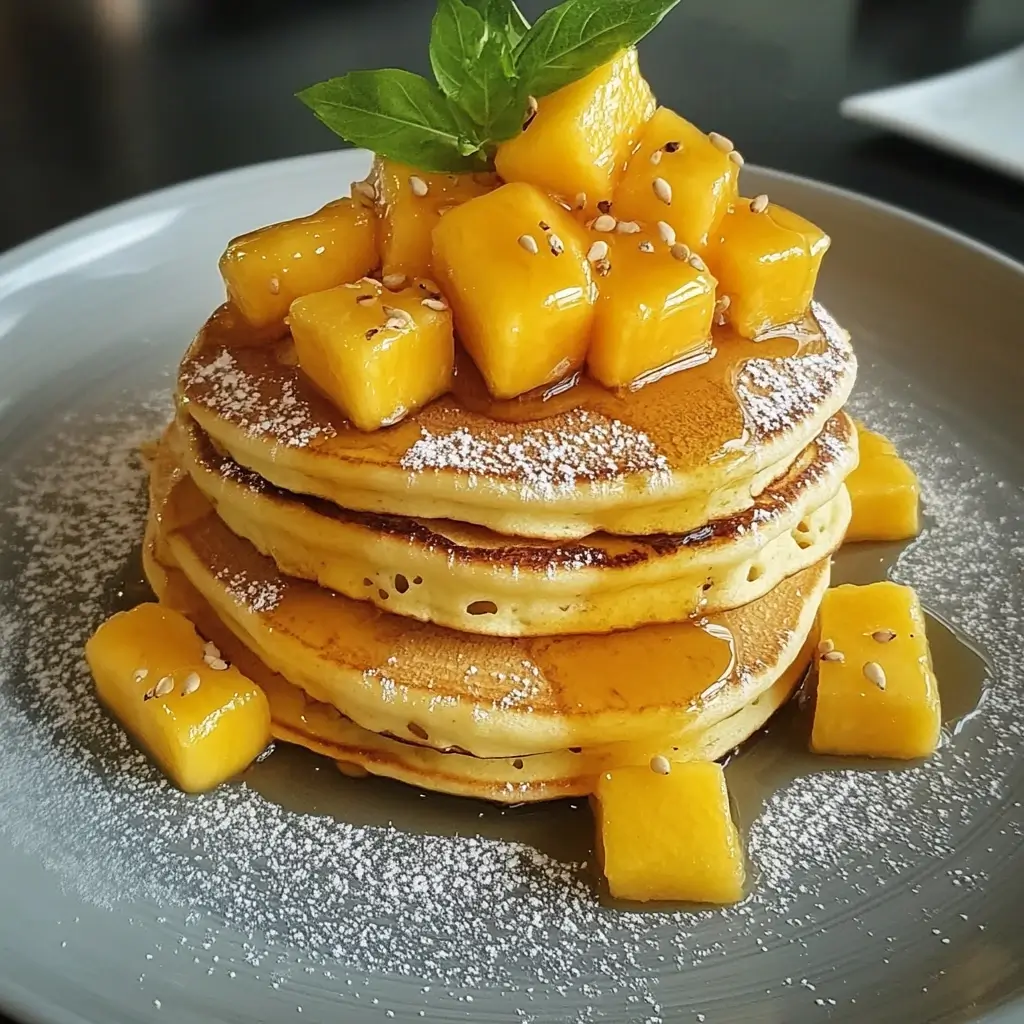Pancakes are a beloved breakfast staple enjoyed by people of all ages, but adding a tropical twist with fresh mangoes takes this classic dish to a whole new level. Mango pancakes combine the soft, fluffy texture of traditional pancakes with the vibrant sweetness of ripe mangoes, creating a delightful breakfast experience that’s both satisfying and refreshing. Whether you’re looking for a quick weekday breakfast or an impressive brunch dish to serve guests, mango pancakes are sure to impress. In this article, we’ll explore everything you need to know about making and enjoying these delicious treats, from ingredient selection to creative variations.
Introduction to Mango Pancakes
Why Mango Pancakes Are a Must-Try
Mango pancakes have quickly become a favorite among pancake enthusiasts thanks to their unique blend of flavors and textures. The natural sweetness of mango complements the buttery richness of pancakes perfectly, offering a taste sensation that’s both comforting and exotic. Unlike plain pancakes, which can sometimes feel monotonous, mango pancakes bring a burst of color and flavor to your plate. This combination makes them ideal for those who want to elevate their breakfast game without much effort.
Moreover, mango pancakes are incredibly versatile. They can be served as a sweet breakfast option, a decadent dessert, or even a light snack during the day. Their adaptability ensures they fit seamlessly into any meal plan, making them a go-to choice for food lovers everywhere. If you haven’t tried mango pancakes yet, it’s time to add them to your culinary repertoire!
Health Benefits of Adding Mango to Your Pancakes
While pancakes may not always be considered the healthiest breakfast option, incorporating mangoes adds significant nutritional value. Mangoes are packed with essential vitamins and minerals, including vitamin C, vitamin A, and dietary fiber. These nutrients support immune function, promote healthy skin, and aid digestion. Additionally, mangoes contain antioxidants like beta-carotene, which help combat free radicals in the body.
When paired with whole-grain flour or almond milk, mango pancakes can become a more balanced meal. By reducing added sugars and opting for natural sweeteners like honey or maple syrup, you can enjoy the indulgence of pancakes while still reaping the health benefits of fresh fruit. For health-conscious individuals, mango pancakes offer a guilt-free way to indulge in something sweet.
Perfect for Any Occasion
Whether you’re hosting a casual weekend brunch or celebrating a special occasion, mango pancakes make a fantastic addition to any menu. Their vibrant appearance and irresistible aroma instantly elevate the dining experience. Serve them at family gatherings, holiday meals, or romantic date nights—they’re guaranteed to impress everyone at the table.
Their versatility also makes mango pancakes suitable for everyday consumption. On busy mornings, whip up a batch of pancakes and top them with pre-sliced mangoes for a quick yet satisfying breakfast. During summer months, mango pancakes pair beautifully with cold drinks like iced tea or smoothies, making them a refreshing treat on hot days. No matter the occasion, mango pancakes deliver unmatched flavor and convenience.
Ingredients You’ll Need for Mango Pancakes
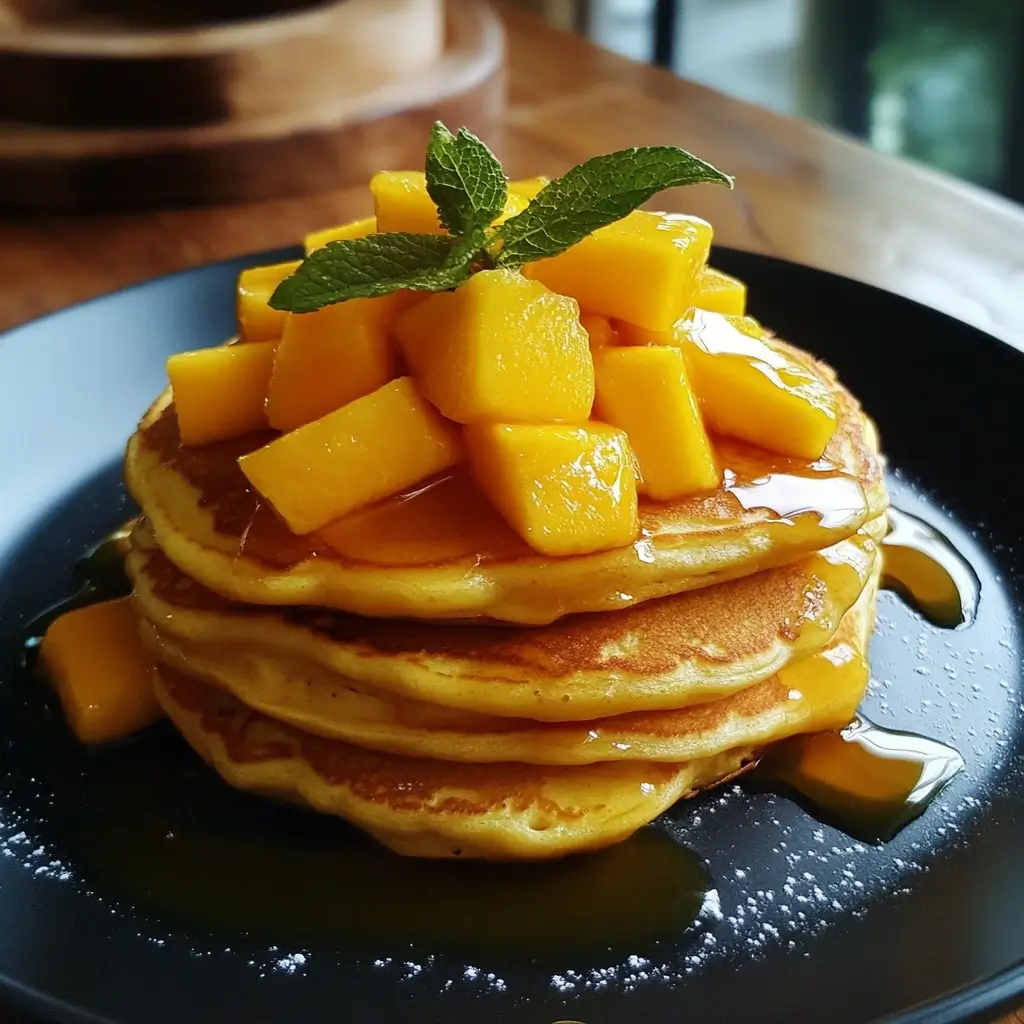
H3: Base Ingredients for Perfect Pancakes
To create the perfect foundation for your mango pancakes, start with high-quality base ingredients. Here’s what you’ll need:
- Flour : All-purpose flour is the most common choice for pancakes because it provides structure and fluffiness. However, you can experiment with alternative flours like whole wheat or oat flour for added nutrition.
- Sugar : A small amount of sugar enhances the sweetness of the pancakes without overpowering the mango flavor. Brown sugar works well if you prefer a richer taste.
- Eggs : Eggs act as a binding agent and contribute to the fluffy texture of pancakes. Separate the yolks and whites if you want extra lift; beat the whites until stiff peaks form before folding them into the batter.
- Milk : Whole milk creates creamier pancakes, but skim milk or plant-based alternatives like almond milk work just as well.
- Butter : Melted butter adds richness and flavor to the pancakes. Alternatively, use oil if you’re avoiding dairy.
- Baking Powder : This leavening agent helps the pancakes rise and become light and airy.
- Vanilla Extract : A touch of vanilla extract elevates the overall flavor profile, complementing the mango beautifully.
Using fresh, high-quality ingredients ensures your pancakes will turn out delicious every time.
Fresh Mango Preparation
The star of the show in mango pancakes is, of course, the mango itself. To prepare fresh mangoes, follow these simple steps:
- Selecting Ripe Mangoes : Look for mangoes that yield slightly to pressure when gently squeezed. Avoid overly hard mangoes, as they won’t be sweet enough, and overly soft ones, which may be overripe.
- Peeling and Cutting : Use a sharp knife to cut around the large pit in the center of the mango. Slice off the flesh in chunks, then dice it into bite-sized pieces. Alternatively, scoop out the mango pulp with a spoon for a smoother topping.
- Storing Unused Portions : If you don’t plan to use all the mango immediately, store the remaining slices in an airtight container in the refrigerator for up to three days.
Fresh mangoes bring a juicy, tropical essence to your pancakes, making them stand out from ordinary recipes.
Optional Add-ins for Extra Flavor
While the basic recipe for mango pancakes is already delightful, there are plenty of ways to enhance the flavor further. Consider adding one or more of the following optional ingredients:
- Honey : Drizzle honey over the finished pancakes for an extra layer of sweetness.
- Cinnamon : Sprinkle cinnamon into the batter for a warm, spiced flavor.
- Coconut Flakes : Toasted coconut flakes add a crunchy texture and complement the tropical theme.
- Nuts : Chopped almonds or pecans provide a nutty contrast to the soft pancakes and juicy mangoes.
- Yogurt : Greek yogurt can be mixed into the batter for added creaminess or used as a topping for tangy contrast.
Experimenting with different add-ins allows you to personalize your mango pancakes according to your preferences.
If you’re looking for a tried-and-true mango pancake recipe, I highly recommend checking out this delicious mango pancake recipe from RecipeTin Eats. It’s one of the best recipes I’ve come across!
Step-by-Step Guide to Making Mango Pancakes
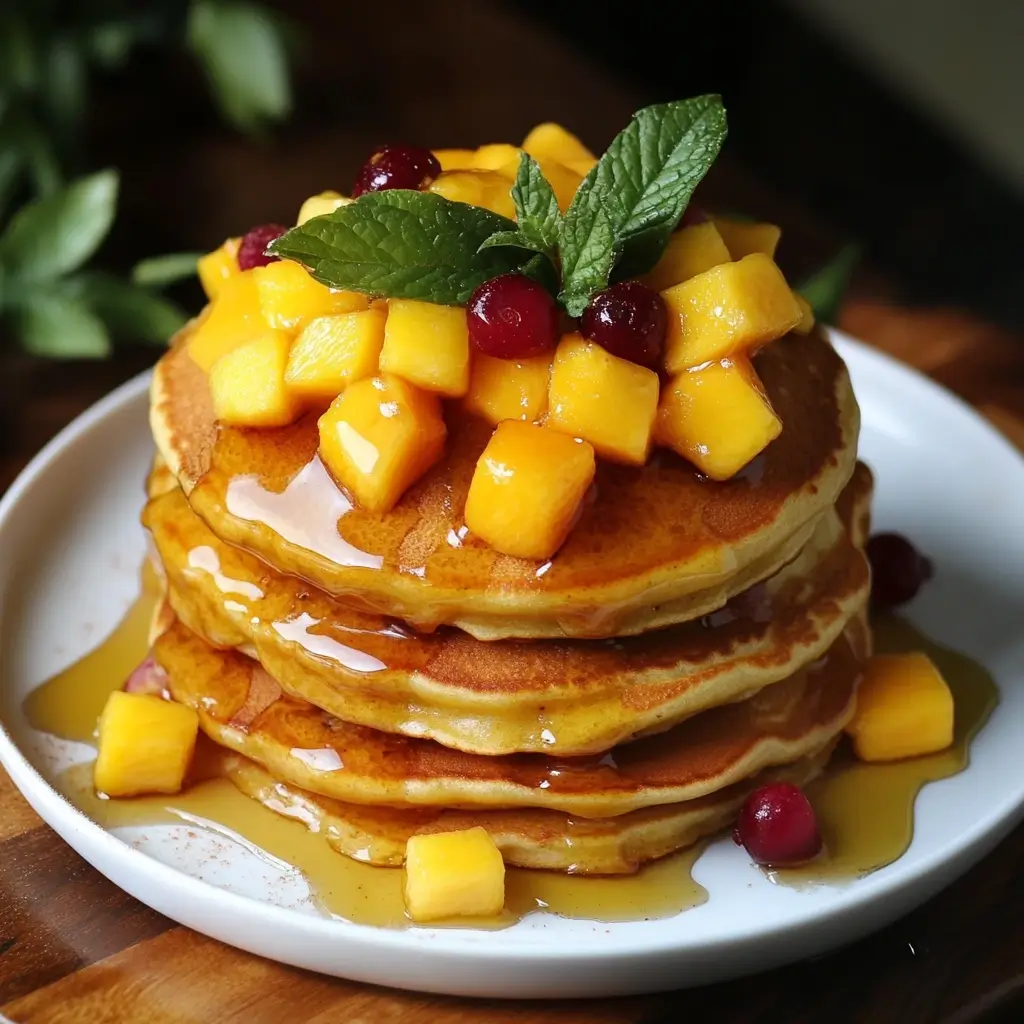
Preparing the Pancake Batter
Creating the perfect pancake batter is crucial for achieving the desired texture. Follow these steps carefully:
- Mix Dry Ingredients : In a large mixing bowl, combine flour, sugar, baking powder, and a pinch of salt. Whisk thoroughly to ensure no lumps remain.
- Combine Wet Ingredients : In a separate bowl, whisk together eggs, milk, melted butter, and vanilla extract until smooth.
- Blend Wet and Dry Mixtures : Gradually pour the wet ingredients into the dry mixture, stirring gently until just combined. Be careful not to overmix, as this can lead to dense pancakes. A few lumps are okay!
- Rest the Batter : Let the batter sit for 5–10 minutes to allow the flour to absorb the liquid fully, resulting in lighter pancakes.
By preparing the batter correctly, you set the stage for fluffy, tender pancakes that pair perfectly with fresh mangoes.
Cooking the Pancakes
Once your batter is ready, it’s time to cook the pancakes. Follow these tips for success:
- Heat the Skillet : Place a nonstick skillet over medium heat and lightly grease it with butter or cooking spray.
- Pour the Batter : Spoon about ¼ cup of batter onto the skillet for each pancake, leaving space between them for spreading.
- Watch for Bubbles : When bubbles begin to form on the surface of the pancakes and the edges look set, flip them using a spatula.
- Cook Both Sides : Cook the second side until golden brown, about 1–2 minutes. Transfer cooked pancakes to a plate and keep warm while you finish the rest.
Proper cooking techniques ensure your pancakes are evenly cooked and maintain their fluffy texture.
Adding Mango Toppings
Topping your pancakes with fresh mango slices or puree takes them from ordinary to extraordinary. Here’s how to do it right:
- Slicing Mangoes : Arrange thin, uniform slices of mango on top of each pancake for an elegant presentation.
- Making Mango Puree : Blend diced mangoes with a splash of lemon juice and honey to create a smooth, creamy sauce. Drizzle this over the pancakes for added moisture and sweetness.
- Creative Garnishes : Enhance the visual appeal by sprinkling chopped nuts, shredded coconut, or fresh mint leaves over the mango toppings.
These finishing touches transform your pancakes into a visually stunning and flavorful masterpiece.
Serving Suggestions
Presentation plays a vital role in enhancing the dining experience. Here are some ideas for serving mango pancakes:
- Whipped Cream : Top the pancakes with a dollop of whipped cream for a light, airy contrast.
- Ice Cream : Serve mango pancakes with a scoop of vanilla or mango ice cream for a decadent treat.
- Yogurt : Pair pancakes with plain or flavored yogurt for a healthier option.
- Fruit Salad : Surround the pancakes with a colorful fruit salad featuring strawberries, kiwis, and blueberries for added variety.
Get creative with your serving styles to keep things interesting and exciting.
Variations of Mango Pancakes
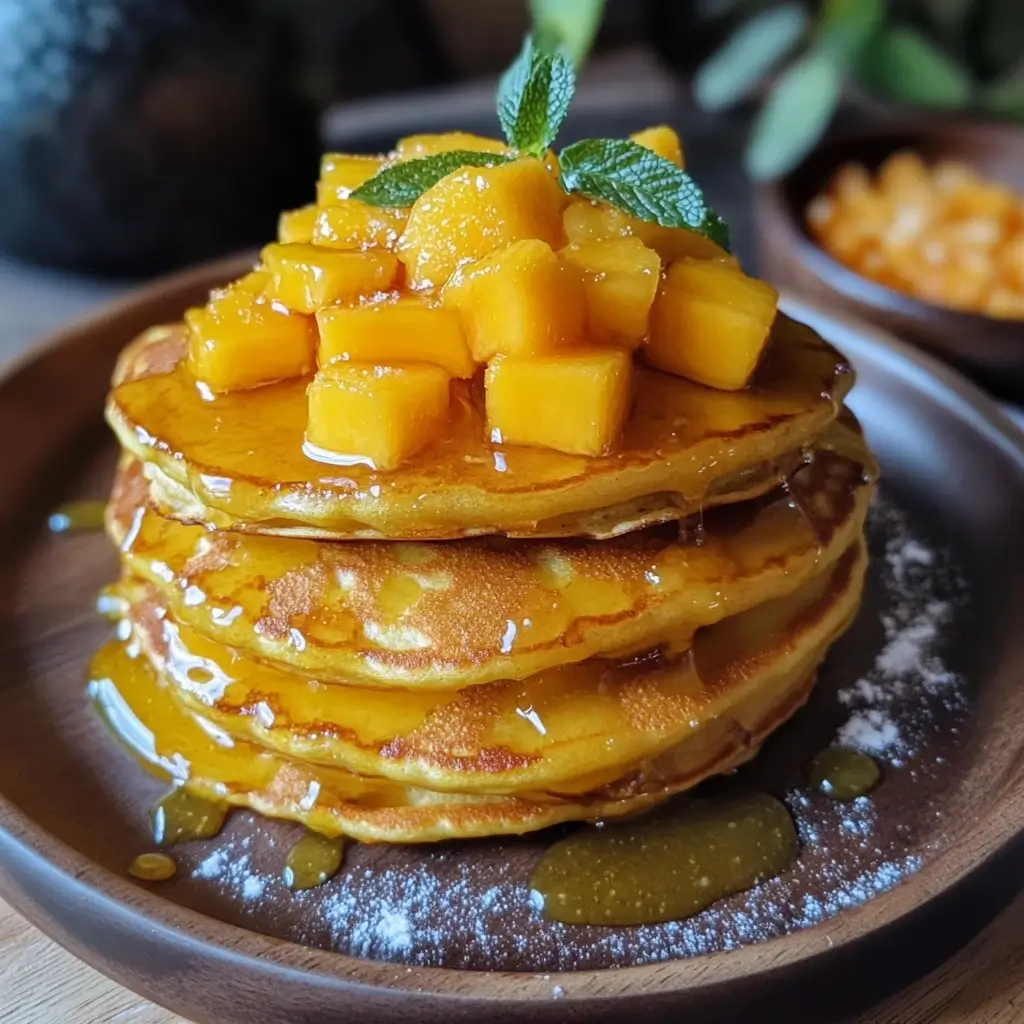
Vegan Mango Pancakes
For those following a vegan lifestyle, making mango pancakes without animal products is easier than ever. Simply substitute traditional ingredients with plant-based alternatives:
- Replace eggs with flaxseed “eggs” (1 tablespoon ground flaxseed mixed with 3 tablespoons water per egg).
- Use almond milk, oat milk, or soy milk instead of cow’s milk.
- Swap butter with coconut oil or vegan margarine.
With these simple swaps, vegans can enjoy the same delicious flavors and textures as their non-vegan counterparts.
Gluten-Free Mango Pancakes
Individuals with gluten sensitivities or celiac disease can still savor mango pancakes by using gluten-free flour blends. Brands like Bob’s Red Mill offer pre-mixed options specifically designed for pancakes. Alternatively, you can create your own blend using rice flour, tapioca starch, and xanthan gum. Remember to adjust liquid quantities slightly, as gluten-free flours tend to absorb more moisture.
Low-Sugar Mango Pancakes
Reducing the sugar content in pancakes doesn’t mean sacrificing taste. Try these strategies:
- Use unsweetened applesauce or mashed bananas in place of part of the sugar.
- Opt for natural sweeteners like stevia, monk fruit, or erythritol.
- Increase the proportion of mangoes in the recipe, relying on their natural sweetness to balance the dish.
These modifications cater to health-conscious eaters without compromising flavor.
Fun Facts and Tips About Mango Pancakes
The History of Fruit Pancakes
Fruit pancakes have been enjoyed across cultures for centuries. In Asia, banana pancakes gained popularity in beachside cafes, while European countries favored apple pancakes. The inclusion of mangoes in pancakes reflects modern trends toward global fusion cuisine, blending traditional techniques with exotic ingredients. Today, mango pancakes represent a harmonious marriage of comfort food and international flair.
Common Mistakes to Avoid
Even experienced cooks encounter challenges when making pancakes. Avoid these common pitfalls to ensure success:
- Overmixing the Batter : Overmixing leads to tough, dense pancakes. Stir the batter gently until just combined.
- Using Underripe Mangoes : Unripe mangoes lack sweetness and juiciness, so choose fully ripe fruits.
- Crowding the Pan : Cooking too many pancakes at once prevents proper browning. Work in batches if necessary.
- Flipping Too Early : Allow pancakes to cook long enough on one side before flipping to achieve a golden crust.
Addressing these issues guarantees consistently excellent results.
Storing Leftover Mango Pancakes
If you end up with leftover pancakes, storing them properly ensures they stay fresh for future enjoyment. Stack the pancakes between layers of parchment paper to prevent sticking, then place them in an airtight container. Refrigerate for up to three days or freeze for longer storage.
To reheat pancakes, microwave individual portions for 20–30 seconds or toast them briefly in a skillet. Reheat mango toppings separately to preserve their texture and flavor.
Conclusion
Mango pancakes are more than just a breakfast dish—they’re a celebration of flavor, creativity, and culinary versatility. By combining the comforting familiarity of pancakes with the vibrant sweetness of fresh mangoes, this tropical treat offers something for everyone, whether you’re a fan of classic recipes or enjoy experimenting with new flavors and techniques. From learning how to select the perfect mango to mastering the art of creating light, fluffy pancakes, each step in the process adds depth and excitement to your cooking experience.
This article has explored everything from the health benefits of incorporating mangoes into your diet to innovative variations like vegan, gluten-free, and low-sugar options. We’ve also shared tips on avoiding common mistakes, enhancing presentation, and even storing leftovers so you can enjoy these delicious pancakes anytime. Whether you’re serving them as a weekend brunch centerpiece or whipping up a quick batch for a weekday morning, mango pancakes bring joy and satisfaction to every meal.
So why wait? Gather your ingredients, fire up your skillet, and let the aroma of freshly cooked pancakes and ripe mangoes fill your kitchen. With their irresistible combination of textures and flavors, mango pancakes are sure to become a staple in your household. Embrace the tropical twist and elevate your breakfast game today! Happy cooking!
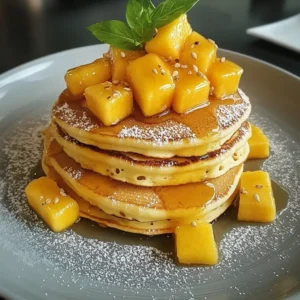
Mango Pancakes
Equipment
- Mixing bowls (large and medium)
- Whisk or electric mixer
- Nonstick skillet or griddle
- Spatula
- Blender or food processor (optional, for making mango puree)
- Measuring cups and spoons
Ingredients
- For the Pancakes:
- 1 cup all-purpose flour
- 2 tablespoons granulated sugar
- 1 tablespoon baking powder
- 1/4 teaspoon salt
- 3/4 cup milk or a dairy-free alternative like almond milk
- 1 large egg
- 2 tablespoons melted butter or oil
- 1/2 cup fresh mango puree about 1 ripe mango, blended until smooth
- Optional: 1 teaspoon vanilla extract
- For Serving:
- Fresh mango slices
- Maple syrup
- Whipped cream or yogurt optional
Instructions
- Prepare the Mango Puree : Peel and dice a ripe mango, then blend it in a blender or food processor until smooth. Measure out 1/2 cup of mango puree for the pancake batter.
- Mix the Dry Ingredients : In a large mixing bowl, whisk together the flour, sugar, baking powder, and salt.
- Combine the Wet Ingredients : In a separate bowl, whisk together the milk, egg, melted butter (or oil), mango puree, and vanilla extract (if using).
- Make the Batter : Pour the wet ingredients into the bowl with the dry ingredients. Stir gently until just combined. Do not overmix; a few lumps are okay.
- Cook the Pancakes :
- Heat a nonstick skillet or griddle over medium heat and lightly grease it with butter or oil.
- Pour about 1/4 cup of batter onto the skillet for each pancake. Cook for 2–3 minutes, or until bubbles form on the surface and the edges look set.
- Flip the pancakes and cook for an additional 1–2 minutes, or until golden brown and cooked through.
- Serve : Stack the pancakes on a plate and top with fresh mango slices, a drizzle of maple syrup, and whipped cream or yogurt if desired. Serve warm.
Notes
If the batter becomes too thick, add a splash of milk to thin it out.
Substitute mango with other fruits like banana or peach for a different flavor profile.
Store leftover pancakes in an airtight container in the refrigerator for up to 2 days. Reheat in a toaster or microwave before serving.

